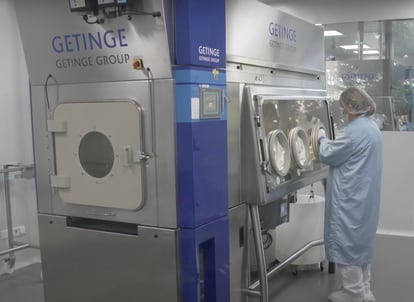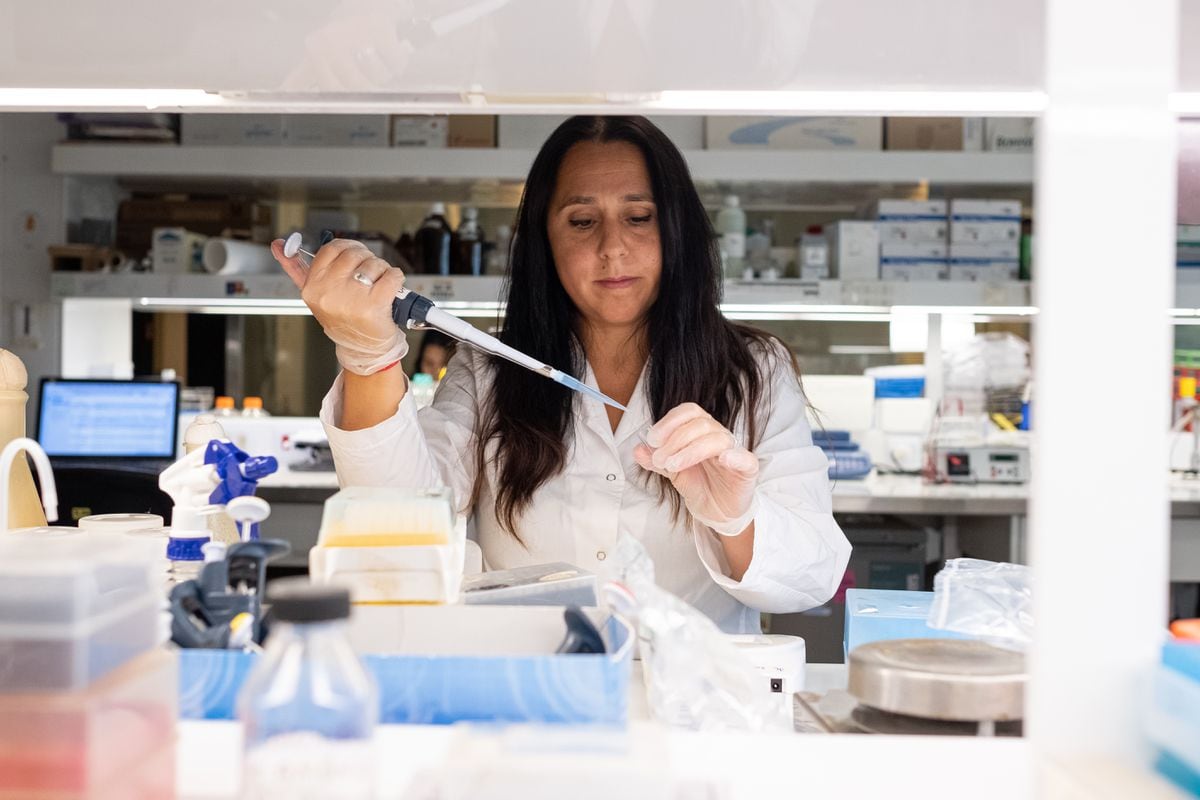The next pandemic is at the doorstep. If no action is taken in the short term, in two decades, the microorganisms that bypass existing drugs will kill 10 million people worldwide each year, more than those who die from cancer and five more than those who died from covid in the past 2020. The geneticist Edith Heard, in an interview in EL PAÍS, focused on this alarm, which has been on for decades in the World Health Organization (WHO) and in the scientific community: “In 10 or 20 years we will be dying for bacterial infections resistant to antibiotics ”. Together with pharmaceutical giants such as Sanofi, Janssen or Pfizer, the Spanish biotechnology company Vaxdyn, in collaboration with a research network and with the support of the Bill and Melinda Gates foundation through the CARB-X entity,develops a revolutionary vaccine against these bacteria. It has successfully passed the early preclinical phases and plans to begin human trials within two years.
More information
The Princess of Girona Foundation awards the biotechnologist César de la Fuente's creation of antibiotics by computer
The setting is dramatic.
According to the WHO, 100 million people are at risk of developing infections by microorganisms resistant to existing treatments and, of the 32 antibiotics under clinical development against priority pathogens, only six are innovative.
Alternatives, such as bacteriophages and lysines from these as well as monoclonal antibodies (the basis of the treatment that Donald Trump received during his covid infection) have not yet cleared up doubts about their safety or efficacy.
Again, the clearest strategy is to immunize the high-risk population, to teach the body to fight these pathogens, to make this dramatic situation bearable with the help of alternative treatments that are still in the experimental phase.
There are currently no vaccines available against the bacteria that pose, according to the WHO, the most urgent threat
But today, there is no vaccine available for the bacteria that pose, according to the WHO, the most urgent threat:
Acinetobacter baumannii,
Pseudomonas aeruginosa
and Enterobacteriaceae such as
Klebsiella pneumoniae.
The priority target population are patients with chronic lung disease, cancer, undergoing dialysis, with chronic liver damage, diabetics, pending solid organ transplantation, women with recurrent urinary tract infections, and neonates.
But the threat is universal.
Microbiologist and biochemist Juan José Infante, 48, explains: “People live with bacteria, many of them live with us, they are in our body and others we acquire from the environment, sometimes in hospitals, but also in many other places. .
Wherever they come from, we control them with our immune system, until they defeat them and infect us.
Since antibiotics were around, we have used them to stop them on these occasions.
But bacteria have become resistant and antibiotics are working less and less.
We have entered the post-antibiotic era ”.
We have entered the post-antibiotic era
Juan José Infante, microbiologist and director biochemist of Vaxdyn
This is where Vaxdyn comes in, a company that emerged in 2011 from the Virgen del Rocío public hospital in Seville and the Institute of Biomedicine in Seville, and of which Infante is executive director and chief scientist. The entity, headquartered in Seville and the first in Spain to receive funding from CARB-X, is developing a vaccine to prevent and alleviate the effects of superbugs. "The goal is to give the population at risk a type of immunity that superbugs cannot defeat," he explains.
Vaxdyn has managed to develop and patent in this time a technology that has been effective in the face of a much more complex challenge than that generated by viruses. According to Infante, "vaccines against bacteria are more complicated to make than against viruses because the former are much more complex organisms, capable of better adapting to the environment and evading immunity." And he adds: “In addition, the objective is more ambitious: to create a vaccine, a single product, that is capable of neutralizing not only one bacterium but several, all the variants circulating throughout the world of each species. That is not easy. There are vaccines on the market against pneumococcus, for example, but against the most worrying ones, those that have developed resistance against all known antibiotics, there was none ”.
Vaxdyn's patent creates immunity against the bacteria's outer membrane proteins and these cannot change much, since if they do, they lose their functionality.
A single vaccination creates protective immunity against a diverse group of pathogens
Vaxdyn's patent creates immunity against the bacteria's outer membrane proteins.
This innovation is key, according to Infante: “If it is possible to create immunity against these proteins, it will be very difficult for bacteria to escape because those proteins cannot change much, since, if they do, they lose their functionality.
Our technology enables that.
Other vaccines act against the sugars, the polysaccharides, of the bacteria envelope.
But the bacteria have learned to modify it and, thanks to that, they escape immunity ”.
The door was opened by Michael McConnell, doctor of medicine from the University of Michigan and current researcher at the Carlos III Health Institute, and Pilar Pérez Romero, principal investigator at the National Center for Microbiology, who founded Vaxdyn from the Institute of Biomedicine in Seville.
As a result of their research on
Acinetobacter baumannii
, one of the species considered critical by the WHO, they discovered that, according to Infante clarifies, “it is possible to vaccinate with a complete inactivated cell of this bacterium once the sugars are removed from the surface, the lipopolysaccharide.
We have also discovered which membrane proteins from other bacteria are key to developing neutralizing immunity against them ”.
Juan José Infante, executive director and chief scientist of Vaxdyn.
The director of Vaxdyn tries to simplify with a common example: “We develop an ice cream of many flavors because we are creating a single immunogenic cell [ice cream] that presents on its surface proteins of the outer membrane of various bacteria [flavors] and therefore , a single vaccination creates protective immunity against a diverse group of bacteria ”.
Unique approach
This approach limits the ability of bacteria to develop resistance to the vaccine.
“These outer membrane proteins”, as Infante explains, “have many regions on which the immune system can act.
If we teach the body what proteins it has to go against, our vaccine generates an entire immune arsenal against which the bacteria will not be able to escape ”.
The biochemist assures that they are the only ones with this vaccination strategy against the proteins of the outer membrane and that it is working.
The support of CARB-X (based in Boston and with funding from the Bill Gates Foundation and entities from the United Kingdom, Germany and the United States) have been joined by the Botín Foundation, the Portuguese Bionova Capital, the Madrid group Arquimea and other investors Spanish people.
Current key research partners include the National Center for Microbiology of the Carlos III Health Institute and the Reig Jofre Laboratories in Barcelona.
Reig Jofre facilities for the development of the Vaxdyn vaccine.
The biotechnology company, which has used around three million euros so far, is now facing a new complex phase that will allow them to start human trials, for which they will require a similar investment in the next two years, in addition to that from CARB- X, secured until the end of clinical phase 1, which will test safety and immunogenicity in healthy volunteers. After this, if the results are satisfactory, they will require new rounds of higher financing and to involve a larger group and with more financial muscle to complete phases 2 and 3, registration and mass manufacturing processes. But Infante is optimistic: "We already have a validated technology and the backing of an international organization that does not invest in just any product."
As multidrug resistance increases, novel and effective therapies and prevention strategies are needed
Francesca Micoli, researcher at the GSK Vaccine Institute
Francesca Micoli, a researcher at the Glaxo Smith Kline (GSK) Vaccine Institute, agrees that antibiotic resistance is a "global threat."
Co-author of a review of vaccines in development against this next pandemic, published in
Nature reviews microbiology
, states that "as resistance to multiple drugs increases, novel and effective therapies are needed, as well as prevention strategies."
"There is no single solution," according to the researcher, "and vaccines are required along with new antibiotics, diagnostic tools, monoclonal antibodies, interventions in the microbiota and the use of bacteriophages to effectively combat drug resistance."
These are the fronts:
Monoclonal antibodies
are directed against the virulence factors of bacterial pathogens (molecules that microbes use to weaken the natural immune response of infected cells), but more advanced developments are aimed at a single target, whereas diseases caused by bacteria are usually multifactorial.
Bacteriophages
. They are viruses that infect bacteria in a specific way. The main advantage is its low toxicity, which allows a large number of phages to be administered in a very small dose.
Microbiota
. Antibiotics not only target pathogens, but can also eliminate the beneficial bacterial community from the patient, which can provide an opportunity for opportunistic pathogens to colonize the human host and cause infections. Oral administration of a mixture of spores of various bacteria isolated from fecal samples from a healthy donor has shown promising results. Eating yogurt with the probiotic strain
Bifidobacterium lactis
BB-12 appears to protect against damage to the gut microbiome associated with taking antibiotics, according to a clinical trial conducted by the Universities of Maryland and Georgetown published in
Nutrients.
Diagnostic tools
. They are the tests that identify and characterize the causative agents of microbial infections, allowing the generation of antimicrobial susceptibility profiles to establish the most appropriate treatment strategy. However, reliable mechanisms do not yet exist for some pathogens and this evidence is not widespread. Researchers at McMaster University have developed a new algorithm-based tool that could help provide early warning of rare and unknown viruses and identify life-threatening bacterial pathogens, according to research published in
Cell Reports
.
Vaccines
. They try, basically and through different strategies, to attack and prevent infection by teaching the body to identify and eliminate the pathogen. Sanofi reached the third phase of a clinical trial against
C. difficile
in people over 50, but stopped it due to low efficacy. Valneva has completed a phase II trial and GSK recently began a phase I trial with and without adjuvant. Janssen and Pfizer are separately investigating proposals based on antigens (inducers of defense reactions in an organism), but the latter's vaccine has not yet shown significant statistical results.
According to Micoli and his research group, "the clinical development of candidate vaccines for bacteria
S. aureus
,
C. difficile
,
P. aeruginosa
, ExPEC and
N. gonorrhoeae
has so far failed."
"This is due," they warn, "to the complexity of the pathogens and the difficulty of performing efficacy trials."
You can follow
MATERIA
on
,
and
, or sign up here to receive
our weekly newsletter
.





/cloudfront-eu-central-1.images.arcpublishing.com/prisa/LXJQLIHEEJDHBNVN45ZLQLAMJY.jpg)



